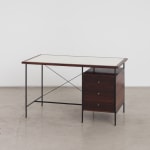








Geraldo de Barros (Unilabor)
Rosewood, Iron, Formica Top, Brass handlers
H 29.52 in. x L 51.18 in. x D 27.95 in.
Further images
-
(View a larger image of thumbnail 1
)

-
(View a larger image of thumbnail 2
)

-
(View a larger image of thumbnail 3
)

-
(View a larger image of thumbnail 4
)

-
(View a larger image of thumbnail 5
)

-
(View a larger image of thumbnail 6
)

-
(View a larger image of thumbnail 7
)

-
(View a larger image of thumbnail 8
)

-
(View a larger image of thumbnail 9
)

This desk was designed in the 1950s by Geraldo de Barros (1923-1998) and produced by Unilabor. Its iron structure supports a Rosewood top covered with Formica – a new decorative solution developed by the industry in the period.
On the right side, below the top, there are three spacious drawers inside a separated rosewood cabinet attached, each with a graceful brass handle. Other furniture designed by De Barros and produced by Unilabor, such as drawers and bookshelves, used this cabinet structure widely.
The system used was part of the industrial constructive reasoning, and the brand language was common to other factories of the time, with straight lines, sobriety, and functionality. Aesthetics innovation appears a combination of iron with wood and laminate reinvestment - new material at the time.
The Unilabor community was founded in 1954 by Geraldo de Barros and a Dominican Priest. He designed and projected furniture based on his constructive references related to Concrete Art. From 1954 to 1961, Unilabor is one of the standing marks in furniture design in São Paulo. Its social characteristic is well renowned, based on principles of community work. Unilabor maintained an equal participation system, where everyone shared the profits and made the decisions together. It was an evident Bauhaus influence.